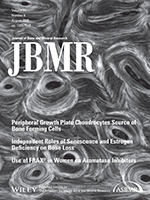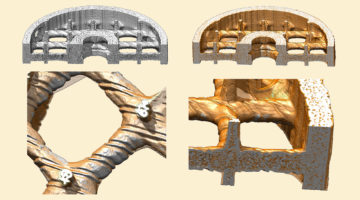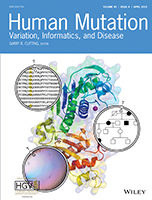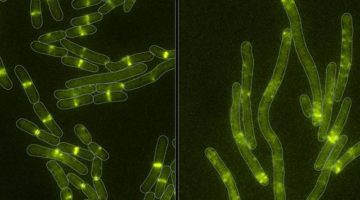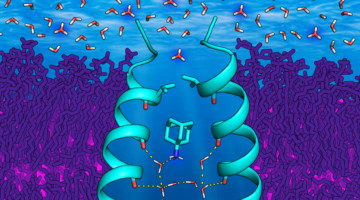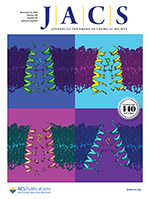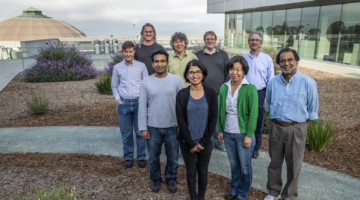Bacterial microcompartments (BMCs) are subcellular compartments found in many prokaryotes, and they are of considerable interest for biotechnological applications. The BMC-H2 shell system constitutes a relatively simple generic building block that could be used to construct designed shells with a relatively highly tunable pore. Read more »
Antibody Uses Mimicry to Block SARS Coronavirus
Protein structures not only revealed how SARS and MERS antibodies inhibit the viruses from attaching to host cells, they also revealed an unprecedented example of receptor mimicry that triggers the cell-invasion machinery of the SARS virus. The results inform efforts to prevent and treat these serious, often deadly, respiratory diseases. Read more »![]()
![]()
Mechanical Competence and Bone Quality Develop During Skeletal Growth
Researchers explored how bone quality and mechanical competence progress during longitudinal bone growth. Deformation at the tissue, fibril, and mineral length scales was investigated with mechanical tensile tests during small and wide-angle x-ray scattering/diffraction (SAXS/WAXD) experiments, revealing dramatic differences in mechanical resistance with age. Read more »
Absorber Captures Excess Chemotherapy Drugs
Researchers have designed a biomedical device for absorbing excess chemotherapy drugs during cancer treatment, characterizing the active surface layer using x-ray microtomography. The work opens up a new route to fighting cancer that minimizes drug toxicity and enables personalized, targeted, high-dose chemotherapy. Read more »![]()
![]()
Biochemical and structural characterization of two variants of uncertain significance in the PMS2 gene
The lack of information as to whether a genetic mutation is pathogenic or benign causes ambiguity during clinical diagnosis and hinders appropriate treatment. Here, researchers use several techniques, including small‐angle x‐ray scattering, to help classify genetic variants associated with an increased predisposition to certain cancers. Read more »
A Two-Pronged Defense against Bacterial Self-Intoxication
Researchers solved the structure of a bacterial toxin bound to a neutralizing protein, revealing two distinct mechanisms for how the toxin-producing bacteria avoid poisoning themselves. The findings offer clues to the evolutionary origins of the potent toxins that enable bacterial pathogens to cause human diseases such as cholera and diphtheria. Read more »![]()
![]()
Comparative morphology of cheliceral muscles using high‐resolution X‐ray microcomputed‐tomography in palpimanoid spiders
Spiders are important predators in terrestrial ecosystems, yet we know very little about their principal feeding structures—the chelicerae—an extremely important aspect of spider biology. Here, using micro‐Computed‐Tomography scanning techniques, researchers perform a comparative study to examine cheliceral muscle morphology in six different spider specimens. Read more »
Toward a Blueprint for Anti-influenza Drugs
Researchers obtained high-resolution structures of several influenza antiviral drug molecules bound to their proton-channel targets in both open and closed conformations. The structures provide an atomic-level blueprint from which to design more effective anti-influenza drugs that can overcome growing drug resistance. Read more »![]()
![]()
Inhibitors of the M2 Proton Channel Engage and Disrupt Transmembrane Networks of Hydrogen-Bonded Waters
The influenza M2 proton channel can bind to drugs and inhibitors. The ammonium groups of these compounds form hydrogen bonds with networks of ordered waters within the channel, and the adamantyl groups sterically block the diffusion of hydronium into the channel pore. Read more »
Scientists Capture Photosynthesis in Unprecedented Detail
Scientists have captured a more detailed picture than ever of the steps in photosynthesis, the process by which plants use sunlight to split water and produce oxygen while making the carbohydrates that sustain life on Earth. The idea is eventually to have a continuous movie of how water is split into oxygen, and how plants do that using sunlight. Read more »
- « Previous Page
- 1
- …
- 13
- 14
- 15
- 16
- 17
- …
- 24
- Next Page »


